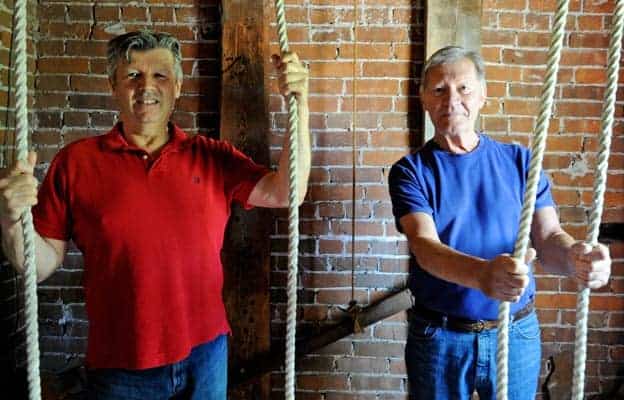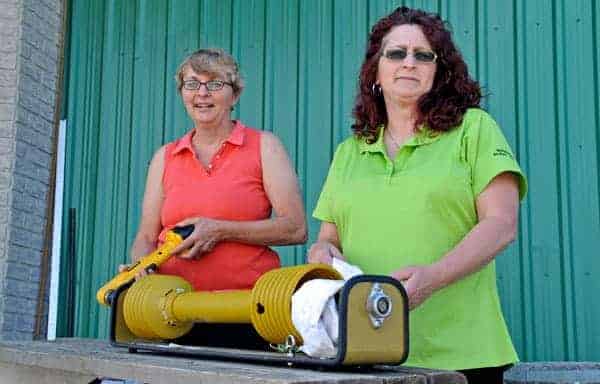![Terry Rohr and Franklin Jonas are two of the main bell ringers who are ringing the St. Matthew’s Evangelical Lutheran Church’s bells in Conestogo for two weeks to recognize the 1,181 murdered and missing aboriginal women and girls between 1980 and 2012 in Canada.[Whitney Neilson / The Observer]](https://www.observerxtra.com/content/images/wp-content/uploads/2015/06/post_bells.jpg)
These church bells were made for ringing, and for telling stories.
For two weeks starting on June 3, the bells at St. Matthew’s Evangelical Lutheran Church in Conestogo will ring 85 times, one for each of the aboriginal girls and women who have been murdered or gone missing between 1980 and 2012. The total number is 1,181, so there will be a few less rings on the last day.
The bell ringing, which is being done across Canada, is in support of the Truth and Reconciliation Commission which finished up in Ottawa this week.
“There’s an assumption that where we live is safe,” Pastor Monika Wiesner said. “Yes there’s murder everywhere. But by and large our towns are safe, our villages are safe. Not all communities have access to clean drinking water. That was a huge focus of our national church’s focus two years ago at our national convention in Ottawa. The medical care is lacking. To not see it as a problem, but as to see the human story and to say that we simply have to reach out to other human beings that have as much right to safety and to everything that we have, just like we have. As a woman I have to say why have these women’s stories been silenced?”
The Evangelical Lutheran Church and the Anglican Church came into full communion with one another about 10 years ago. Now, the Anglican Church is facing a lot of backlash over the residential school system. Wiesner says they began to focus on what their issues were as well and they learned an awful lot they didn’t know.
“It’s to draw attention to the fact that it isn’t just the indigenous community, it’s women,” Wiesner said. “A lot of the women got behind it to say who’s the voice of the women? Maybe it needs to be other women.”
While no Aboriginal people attend the church in Conestogo, the Evangelical Lutheran Church branch has a connection with the Six Nations people in Brantford. And Conestogo might actually have more ties to aboriginal beginnings than we believe.
“I have learned recently from the First Nations community that where two rivers come together they always consider that to be sacred ground,” Wiesner said. “I looked up where the two rivers, the Grand River and the Conestogo River come together and it’s here in Conestogo. I thought how much more important for us then to ring.”
The church also did bell ringing against climate change in 2009 when the Copenhagen climate change summit was happening.
“Our bells can do a lot of speaking for us,” Wiesner said. “I didn’t really understand that as well until we started ringing for climate change. When the wind is going in a certain direction they hear our bells way over in Winterbourne.”
They decided to do the bell ringing over two weeks because 85 rings a day is something a couple of people can manage. The men largely responsible for ringing those 400 and 800- pound bells at 6 p.m. are Terry Rohr and Franklin Jonas. They’ve been ringing the bells since they were teenagers, now both in their 70s. They’ll be helped by Dave Martin and Dave Gromeder.
“[It was] just the challenge at first,” Rohr says as to why he started. “It’s a real rhythm to get with somebody else, you’ve got to get between each other at the same time.”
They’re the only bells the church has ever had, and one of the only things to survive the church fire in 2003. It remains a mystery how they survived, since the fire started in the organ loft, close to the bells.
“Our special friend Maynard Gies, he was the bell ringer for years and years and his father before him,” Jonas said. “He brought us over here and showed us the ropes, you might say.
The church will be open during the bell ringing each night for interested people to see the bell ringers in action.
They have a strong prayer shawl ministry within the church that makes prayer shawls and blankets. They’re planning to send some of those to Six Nations or other First Nations communities who would find comfort in them.
“I think everything is awareness building and education to get people on board,” Wiesner said. “I think by and large it’s not that people don’t care, people don’t know. That’s what we’re hoping to do with the bell ringing. We have a link to the school next door, so we want the children to know because they’re all going to hear it. We’d really like the children to know why the bells are ringing every night and why for so long. Maybe that will encourage the teachers at the appropriate level of understanding to share with the children the stories of our First Nations people.”
The Truth and Reconciliation Commission’s goal was to help aboriginal and non-aboriginal people come together to record the stories of people who lived through residential schools.
“Each ring is a woman and it would be really lovely to put names to it. Right now we have to just ring the bells,” Wiesner said. “Each one is a woman and each woman has her story. And each woman has loved ones that are grieving for her. It’s the human factor that we’re really trying to lift up. Each ring is a woman or a young girl.”









